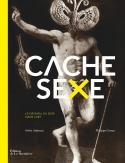Cache-sexe, le désaveu du sexe dans l’art
Sylvie Aubenas and Philippe Comar
"No Sex Please, We’re Artists": we could almost borrow this sentence from a famous English play to prove the censure that weighed down for centuries on the representation of sexual organs in painting and sculpture. The famous Origine du monde by Courbet in 1866 was an isolated flash of lightning: in the middle of the 20th century, its owner, Jacques Lacan, had even had a painting-screen by André Masson to hide it (shown at the exhibition) and it was only presented to the public for the first time in 1988. The authors carried out a pleasant investigation on the strategies to hide and cover, which owe a lot to the Christian religion: the Savior had aperizonium as of the first centuries while the condemned were crucified nude. From the fig leaf in the Book of Genesis (which in Europe became a grape leaf), up to the loincloth, the screens are very varied: the branch of a cactus for Abel, a sword sheath for Mars or Belisarius, her hair for Venus or his club for Hercules. But there were also pieces of cloth, grape seeds, feathers, petals, even butterflies! With a perverted effect as well: these obstacles have a tendency sometimes to attract the eye precisely where it is not supposed to focus.
|  |
Review published in the newsletter #360 - from 16 October 2014 to 22 October 2014
